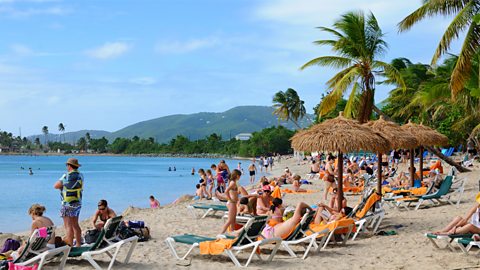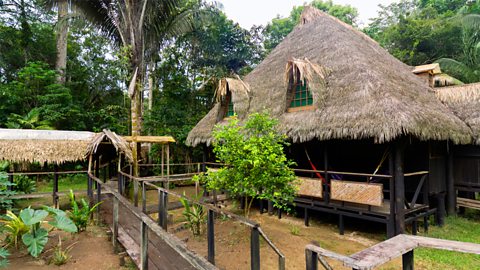The growth of tourism
Tourism is one of the world's fastest growing industries but the industry was badly hit by the COVID-19 pandemic. Before the lockdowns and restrictions on travel, tourism had more than doubled since 2000. However, the signs are that tourism has already got back to pre-pandemic levels.
In 2023, 1,286 million people were recorded as arriving in a country from abroad because of tourism, almost as high as the 1,462 million in 2019.
Leisure tourism spending worldwide was $4,067 billion, making tourism one of the world's largest industries.
The graph shows the growth in tourism measured by international arrivals. Source: World Tourism Organization (UNWTO).
In 2010, the Middle East and Asia had the greatest growth of tourists.
In 2023, post-pandemic, the two largest destinations for international travellers were France and Spain with over 70 million visitors each. These are followed by Turkey and the USA ÔÇô both with over 40 million visitors in 2023.
Europe still has the greatest number of tourists - 428 million in 2023.
| 2019 | 2023 | change | |
|---|---|---|---|
| Americas | 123 | 117 | -4% |
| Asia Pacific | 213 | 149 | -3% |
| Europe | 440 | 428 | -30% |
| Middle-East | 29 | 33 | +13% |
| Africa | 49 | 43 | -13% |
The tourism industry therefore is very important to economic growth as well as the environment.
Tourism can help a country's economy and infrastructureThe basic structures needed for an area to function, for example roads and communications. as it provides jobs. Some countries such as the Caribbean have tourism as their main source of income.
Mass tourism is what happens when there are large numbers of people who go on holiday to the same resort, usually at the same time of year.
Usually, tourists will have purchased a package deal that includes flights, transfers and accommodation.

Impact of mass tourism
mass tourismThis is what happens when there are large numbers of people who go on holiday to the same resort, usually at the same time of year. means that there are hundreds of thousands, if not millions of tourists who will descend onto a variety of tourist resorts each year.
In the UK, tourism was providing about 6% of Gross Domestic Product (GDP)Measures the wealth or income of a country. It is the total value of goods and services produced by a country in a year. before COVID. In 2020 it had dropped to just 3% but is steadily increasing again.
This means that tourism has cultural, economic and environmental impacts.
Cultural impacts
| Positive impacts | Negative impacts |
|---|---|
| Tourists learn about other cultures. | Some traditional roles (such as farming) will be lost in order to provide tourist services. |
| Different cultures can learn from each other. | Tourist behaviour can lead to locals feeling that their culture and beliefs are minimised. |
| Tourists bring money which can breathe new life into neglected areas. | Local languages might be lost as people prefer to use international languages such as English. |
| Local crafts might be revived to be sold to the tourist market. | Crime and anti-social behaviour might rise as more and more tourists visit a place and bring their own social problems with them. |
Economic impacts
| Positive impacts | Negative impacts |
|---|---|
| Increased employment. Over 320 million people around the world were employed in the tourism industry in 2023 and this is forcecast to rise by 110 million by 2033. | Many tourism services are of little value to local people. |
| Brings huge amounts of foreign currency into a country. This can help stabilise an economy and prices in a country. | The cost of investment in roads or infrastructure will have to be borne by the local people. |
| Tourism companies make a profit which can either be invested into new facilities in a country or back into the business. | The character of a place might change. Local shops might be displaced by shops that cater solely for tourists. |
| Improvement in general infrastructure can help local people. | Traditional jobs will be lost as an area switches focus in providing for tourists needs. |
| Profits may ÔÇÿleakÔÇÖ out of an area and back to the headquarters of a multi-national tourism organisation or hotel chain. |
Environmental impacts
| Positive impacts | Negative impacts |
|---|---|
| Many tourist organisations are trying to create a more sustainable ethos for tourism. This helps to protect the animals and local environment and will be funded by the tourists who visit. | Overcrowding can impact fragile environments and soil will be eroded away. Damage to the ecosystem might totally change the characteristics of a place. |
| Provides money that can help local people to protect their environment. | Overcrowding can cause congestion and pollution. It will increase the carbon emissions in an area. |
| Can also help raise awareness of different issues such as water shortages or endangered animals. | Tourists will increase the amount of waste and sewage in an area and this will need to be dealt with in a sustainable manner. |
| Improvements and investment in derelict areas and spaces that cannot be used for any other purpose. | More pressure on scarce water supplies. Many tourist facilities require increases in the use of water and this can lead to local people losing access to clean drinking water. |
Effects of mass tourism
More affordable travel has led to some places in the world being significantly damaged by tourism. Budget-friendly package tours and cheap flights to all-inclusive resorts, allow large numbers of tourists to arrive at popular destinations, most likely during the summer months. Cruises are also a form of mass tourism.
There are a number of impacts:
- Places like Cape Town in South Africa have become cheaper to visit. Some visitors like the place so much and, as property is affordable, buy a house or apartment. Some of these will become holiday homes while others may berented out as Airbnbs or similar. This pushes prices up and makes it very difficult for local people to own their own home.
- Bali was once an unspoilt island in Indonesia but its capital city is now congested with traffic and pollution, and the beaches are crowded and the local authorities have to manage the amount of rubbish created by visitors.
- Some countries are trying to address the problems. Machu Picchu, in Peru is a destination that may tourists want to visit. The damage to the site by uncontrolled tourism has been considerable and so, since 2017, the Peruvian government have restricted access to Machu Picchu to groups of 16 or less, with an official guide.
Responsible tourism

This is any form of tourism that is conducted in a more responsible manner.
A responsible tourist respects the environment of the places being visited, but also respects the cultures and societies of the people who live there.
Tourists will do their best to minimise any negative social, environmental or economic impacts on the local people and will aim to enhance any community that they come into contact with.
The United Nations World Tourism Organization (UNWTO) has prepared a special booklet called ÔÇÿTips for a responsible travellerÔÇÖ.
This booklet emphasises the point that travellers should ensure that travel is as rewarding and gratifying for the traveler and for the people they meet and the places they visit:
Honour your hosts and our common heritage: Make sure that you know local customs, traditions, social conditions and try to use the local language. Make sure you have permission before taking photos.
Protect our planet: Be a guardian of natural resources, respect wildlife by not using products that might endanger plants or animals. Only visit places open to visitors and avoid protected areas, leaving as small a carbon footprintThis is the total set of greenhouse gas emissions that are caused by an organisation, event, product or person. However, it is more usually taken as a measure of carbon dioxide and methane emissions within a population. as possible.
Support the local economy: Buy locally-made goods and pay a fair price, make sure that all products are acceptable within national and international law. Use local guides who have an in-depth knowledge of the area.
Be an informed traveller: Make sure that you take the right health and safety precautions on your trip, know how to access medical care and choose tour operators with a proven track record in sustainability and community projects.
Be a respectful traveller: Observe all national laws and regulations, ensuring that you respect human rights. Refrain from giving money to people who beg on the streets but support local community projects. Take photos instead of bringing cherished cultural objects home.
Ecotourism

Ecotourism is a type of sustainable developmentEconomic development which meets the needs of the current population without polluting the environment or depleting natural resources.. The aim of ecotourism is to reduce the impact that tourism has on naturally beautiful environments.
Any tourist destination can be harmed by increased levels of tourism. If areas are damaged or destroyed, they might not be available to future generations.
Ecotourism is environmentally sound so that natural environments and wildlife are protected; natural resources are protected in a sustainable tourismTourism that takes full account of its current and future economic, social and environmental impacts addressing the needs of visitors, the industry, the environment and host communities way and that tourism is socially appropriate.
The ecotourism approach
Ensuring that tourism does not exploit the natural environment or local communities.
Consultation with local communities on planned developments.
Making sure that infrastructure improvements benefit local people and not just tourists.
ecotourismTourism which is environmentally sound so that natural environments and wildlife are protected. now has the backing of the United NationsThe successor to the League of Nations, the United Nations was established in 1945 as an international organisation designed to keep peace, uphold international law and set standards in human rights., which made 2002 the International Year of Ecotourism.
Guidelines for ecotourists
Ecotourism sets out guidelines for how tourists should behave when visiting fragile environments:
Protect the environment - keep to footpaths, don't leave litter or start fires.
Don't interfere with wildlife - don't scare or feed the animals.
Protect resources - don't take too many showers or use air conditioning.
Support local communities - stay in locally owned accommodation and buy produce from local people.
Eat local food and drink - avoid products that have been imported from MEDCMore Economically Developed Country ÔÇô usually a rich country found in Western Europe or North America..
Respect local customs and traditions - some communities are offended when tourists wear inappropriate clothes in religious places, strip off on the beach or behave in a rowdy manner. Locals appreciate tourists who try to learn the language and show an interest in their culture.
Ecotourism is increasingly popular and many people appreciate remote locations, small numbers of tourists and less sophisticated facilities.
If a resort becomes overdeveloped then they will choose alternative destinations.
Case study: Ecotourism in the Maasai Mara, Kenya

Tourism brings income to Kenya and gives tourists a greater understanding of the area's animals and plants.
The Maasai Mara is located in the southwest of Kenya, and covers an area of 1 510 square km (583 square miles). The National Reserve is especially popular for safari holidays, offering tourists the chance to observe the Great Migration of wildebeest and zebra in July and August each year. Before COVID-19, Kenya was attracting over 2 million visitors each year, many of them going on safari, and this is forecast to recover by 2024 increasing to 2.2 million.
Tourism can also negative impacts on the area. These need to be managed carefully to ensure that the natural environment isn't damaged for future generations. The Maasai Mara, especially during the Great Migration can become overcrowded and some estimates suggest that there are twice as many visitors to the park during peak months.
The Kenyan government has set up very strict rules about how hotel chains can ensure they balance the needs of the tourist and the needs of the local community.
Ecotourism Kenya runs a standards scheme where 86 facilities have received 23 Gold, 43 Silver and 20 Bronze standard eco-rating certificates.
Ecotourism can play a large part in helping to ensure that there are many social and economic positives coming from ecotourism.
These include:
Providing well-paid, stable jobs for the locals - these jobs include a wide range of services for tourists.
High quality education and staff training - many employees and their families will be supported through their education and will be encouraged to continue to learn through their career development.
ÔÇÿCommunity Development ProjectsÔÇÖ - many of local hotels and safari lodges and camps have set up their own ÔÇÿCommunity Development ProjectsÔÇÖ where they will support the local community by helping to build homes and infrastructure, wells and water supplies, telecommunications and electricity. Many are also involved in helping improve the healthcare of local communities and will work closely with doctors and health organisations to improve the health of local people.
Education - some organisations will also support local schools and make sure that they are provided with all the provisions that will encourage children to go to school.
However, perhaps the largest impact that ecotourism can make is in how it can help to impact the environment. These include:
Supporting local conservation efforts ÔÇô the money that tourists pay will help to pay for local guides and rangers who will be tasked with helping to protect the land and the wildlife in a particular area. This could also enable scientific research that might help to sustain animal numbers. Training will be given to local guides so that they do not disturb the animals. Jeep and minibus numbers will be kept to a minimum to ensure that new tracks are not created which can cause soil erosionWhen earth is washed or blown away..
Sustainable buildings ÔÇô any new building for a hotel or safari lodge needs to be planned carefully so that it integrates into the environment easily. Local products should be used so that they do not need to be transported long distances.
Water ÔÇô water management systems should be developed to ensure that new building will not take too much water away from the local ecosystem. Grey water (from washing) and black water (from toilets and sewage) needs to be filtered and reused.
Electricity ÔÇô should be generated from a sustainable source such as solar energySolar power is a renewable energy that is created using the sun to create power. The sunÔÇÖs heat and light is converted into electricity using the energy of speeding photons within a solar panel..
Waste ÔÇô should be recycled as much as possible so that there is very little that needs to be incinerated. Strategies for managing waste and for encouraging recycling should be emphasised within every resort.
As a result, any new tourism development in the area should not have any negative environmental impact on the local environment and if anything, should have a positive impact. If tourist operators do not meet minimum standards of sustainable tourism, they have their licences suspended.
The Kenyan Government recognise that there is a strong call for sustainable tourism from tourists themselves. 71% plan to make eco-friendly travel decisions, 73% want to stay in an eco-sustainable hotel and 50% are willing to pay more for socially responsible products.
More on Managing our environment
Find out more by working through a topic
- count1 of 3

- count2 of 3
